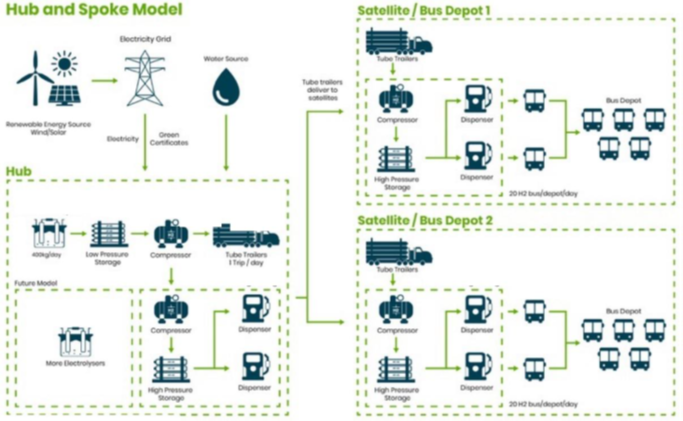The Intergovernmental Panel on Climate Change (IPCC) issued a code red. Code red translates to an imminent risk of reaching 1.5°C warming in the near term if emissions continue at their current rates (Masson-Delmotte et al., 2021). The world is far below the required 12.9% per year decarbonisation rate and is unlikely to come close to meeting the 1.5°C Paris Agreement goal.
Transport is a significant contributor to global carbon emissions. At around around 20% of global emissions it is less than energy production 36.5% and other industrial processes 21% but still significant (Statistica 2022). Australia is only just beginning to focus on decarbonising the transport sector and buses are a good place to start.
Zero emission bus technology is mature and in operation around the world. Electric and hydrogen fuel cell electric busses are complimentary and together can provide the full suit of services. In Australia, the jurisdictions are setting emission targets and developing transition strategies.
In Queensland all new buses from 2025 must be ZEB and the electric Metro bus in Brisbane is in trail operation. Sydney will transition its 8000 diesel bus fleet to electric and hydrogen by 2030 and Victoria commits to all new bus purchases from 2025 will be zero emissions. However, uptake is constrained by the lack of clear funding options, existing contractual arrangements, the ability of local bus manufacturing to supply ZEBs and other operational constraints.
ARRB is working with clients to achieve their net zero goals. Proving the research and understanding the opportunity. A recent study undertaken for Lion Energy looked into vital aspects of a pathway to integrate fuel cell electric buses (FCEBs) into existing bus services in Queensland. The study compares the two major zero emission bus (ZEB) technologies – battery electric buses (BEBs) and hydrogen FCEBs.

The cost of transporting hydrogen is not insignificant and the study found a hub and spoke model is the most likely option for deployment of hydrogen. FCEBs can be refuelled offsite and provide bus operators with an alternative to investing in electric charging infrastructure.
Shift to zero-emission public transport requires a collaborative systems approach that considers the whole supply chain. Energy providers working with bus operators, bus manufacturers, charging and refuelling infrastructure providers and financiers to optimises delivery of new system. Government can assist by reconfiguring procurement and contractual arrangements to accommodate new energy and bus consortia and different financial structures and bus operations.
The study also highlights the role of FCEB in an integrated zero emissions bus strategy to overcome operational constraints related to bBEB charging infrastructure and energy draw. FCEB also complement BEB in terms of distance and duty cycle requirements.
What are the infrastructure constraints in ZEB and FCEB deployment? What are the factors that will lead to a viable business model including TCO? What are the supply chain requirements and who is in the market? ARRB's Mobility Futures Team can assist you in answering these and other low- and zero-emission transport questions about our sustainable future. For more information about the project and capabilities of the team, contact Renata Berglas, Mobility Future Business Leader, ARRB.
References
Masson-Delmotte, Valérie, Panmao Zhai, Anna Pirani, Sarah L. Connors, C. Péan, Sophie Berger, Nada Caud, et al., eds. 2021. Climate Change 2021: The Physical Science Basis. Contribution of Working Group I to the Sixth Assessment Report of the Intergovernmental Panel on Climate Change. Cambridge University Press.
PWC. 2021. “Code Red - Asia Pacific’s Time to Go Green.” https://www.pwc.com/gx/en/asia-pacific/net-zero/asia-pacific-code-red-to-go-green.pdf.
Karlsson, 2021 Actions Necessary to Help Facilitate Global Trade in Hydrogen: Role of the International Partnership for Hydrogen and Fuel Cells in the Economy, presentation to the 2nd MENA Energy Summit, International Partnership for Hydrogen and Fuel Cells in the Economy, Brussels, Belgium, viewed 3 February 2022,<https://www.iphe.net/_files/ugd/45185a_f245faeeb89a489d821267d17bd0f721.pdf>.
Statistica 2022 https://www.statista.com/statistics/1129656/global-share-of-co2-emissions-from-fossil-fuel-and-cement/
